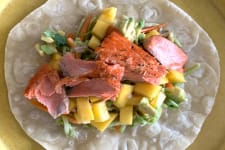
Cooking Halibut Temperature Guide
April 18th, 2025Best Internal Temp for Halibut
Knowing the internal temperature of halibut allows you to effortlessly prepare flaky, tender fillets. This lean species can overcook easily, if you’re not keeping a close eye on doneness. Whether you’re grilling, baking, or pan-searing, cooking the halibut to the right temperature is crucial for fillets with the best taste and texture.
When cooked to the ideal internal temperature, this delicate species is juicy and flaky. But if you cook halibut too long, you risk a dry, tough fillet. Undercooked halibut can also have a tough quality. Follow this guide to halibut cooking temperatures for perfectly tender fillets every time.
Halibut Temperature Guide by Doneness
Unlike salmon, which some people prefer medium-rare for the best texture, halibut tends to be flaky when it is just cooked through to a medium doneness. The easiest way to gauge the internal temperature is to use a reliable instant-read thermometer, using the following as a temp guide:
Internal Temperature for Halibut
-
Medium-rare: 125-130°F
-
Medium: 130-135°F
-
Medium-well: 135-145°F
-
Well Done: 145°F+
Note: The FDA recommends that any variety of seafood be cooked through to a well-done internal temperature of 145°F to best reduce the risk of foodborne illness. However, halibut can be very dry and tough at this level of doneness. It likely won’t flake easily with a fork, and may have a rough, unpleasant texture.
How to Measure Halibut Temperature
An instant-read thermometer is one of the most valuable tools in the kitchen for measuring the doneness of halibut. It may take you a little practice to use this tool and get an accurate reading from halibut, but once you understand how to use it, you’ll be able to get an objective understanding of halibut doneness every time.
-
Insert the pointed end into the center of the halibut fillet, where it is the thickest.
-
Don’t go too far into the fillet, as you may end up poking the probe of the thermometer through to the hot cooking surface. This will give you an inaccurate reading that is likely hotter than the real internal temperature.
-
On the other hand, if you’re not far enough into the fillet, you likely are getting an inaccurate reading that is cooler than the real internal temperature of the halibut.
-
If you’re cooking halibut steaks, be mindful that they may be bone-in cuts — you want to make sure you’re measuring the temperature of the halibut meat, not the bones.
-
Once the temperature gives you the reading you’re looking for, you can remove the halibut from the heat to let it rest.
Factors That Affect Halibut Cooking Temperature
There are three primary influences on how your halibut will cook: fillet thickness, cooking method, and carryover cooking.
-
Thicker cuts of halibut need more time to cook than thinner cuts, no matter which cooking method you use.
-
Different cooking methods also can affect the cooking temperature of halibut. For example, a grill or pan’s direct heat will cook your halibut to the correct internal temperature faster than baking — but it can also be harder to monitor the temperature when it cooks so quickly, as even a minute too long can be the difference between moist, flaky halibut or a dry, tough fillet.
-
Carryover cooking is when food continues to cook once it’s been removed from the heat. The effects of carryover cooking are more pronounced when using hotter, more intense preparations.
Signs of Perfectly Cooked Halibut
If you cooked your halibut to the ideal internal temperature, you should end up with moist fish with opaque white flesh (not translucent). The halibut should easily flake apart with a fork and feel a bit firm, not mushy or hard.
Tips to Avoid Overcooking Halibut
-
Halibut is delicate — it can go from perfectly cooked to dry and tough in no time. With that in mind, always use a thermometer! Don’t rely on visual clues alone.
-
Remove the fillet from the heat a few degrees before it hits your target internal temperature, then let it finish cooking while it rests for a few minutes. Resting allows the fillet’s juices to redistribute so it’s as flavorful and moist as possible.
-
If you’re having trouble with halibut doneness, try using a gentler heat — low temperature baking or steaming can give you a little more grace when you cook halibut.
Frequently Asked Questions
How can I tell if halibut is cooked without a thermometer?
Ask yourself a few questions: Is the flesh white and opaque? Does it flake easily with a fork? When you press it with your finger, does it feel firm, not hard or spongy? If it’s a yes to all, you probably have perfectly cooked halibut. However, if you’re not sure what to look or feel for, it’s always best to use an internal thermometer as an objective measure.
Should I adjust the cooking temperature or time for frozen halibut compared to fresh?
Yes, you need to adjust your cooking time if you cook frozen halibut. Frozen halibut takes longer to cook than fresh or defrosted halibut. Add 3-5 minutes per side for pan-seared or grilled halibut, until the center of the fillet is cooked to your liking. Remember that the exterior of a frozen fillet will cook much faster than the center, so it maybe be harder to control the doneness of the halibut. Try air frying halibut from frozen for better, more even results.
Can you eat halibut medium-rare?
Yes, you can eat medium-rare halibut, but it’s critical to understand that eating any seafood that is not fully cooked through can expose you to an increased risk of foodborne illness. In terms of texture, medium-rare halibut can be a bit tough, as the fillet will still be raw in the center.





